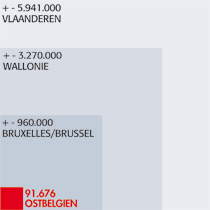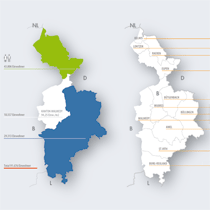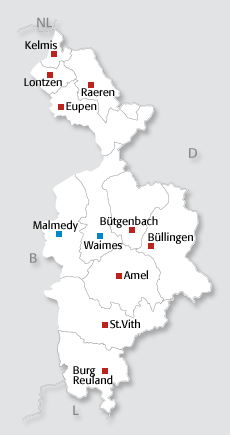People in East Belgium
The population of east Belgium sees itself as living in the European core area with carefree access to four different countries (Belgium, Germany, the Netherlands and Luxembourg). They identify themselves with the German or the French language; through media and daily contacts, they hold a close relationship to the German culture and/or the Roman area.
People speaking German are, in general, loyal Belgians and very devoted to the monarchy. They feel that they are sufficiently represented within the government, since German has been recognized as one of the three official and legislative languages. The political autonomy of the German language community has significantly supported the fact that the German language population also sees itself as a valued component of the Belgian state. The transition since 1920 has been easier for the French-speaking people of the canton of Malmedy.

In the last few years, the population has increased, particularly in the North. The main reason is the migratory movement between the Federal Republic of Germany and Belgium. More and more German citizens settle in the neighboring kingdom of Belgium, since real estate prices here are significantly lower and they can also profit from tax advantages. The community of Raeren, for example, currently shows approximately 45% German inhabitants, the community of Kelmis approximately 30%.
From a linguistic point of view, German citizens have no integration problems since it is the native language of most East Belgians. The linguistic diversity in east Belgium is strongly supported because of the proximity of the French language communities, the border, and the significance of the French and Dutch language in Belgium. Most East Belgians speak three, sometimes even four languages (German, French, Dutch, and English).
Population density
 The demographic North-South-divide becomes particularly obvious when comparing the northernmost and southernmost communities:
The demographic North-South-divide becomes particularly obvious when comparing the northernmost and southernmost communities:
- The most densely populated community of the total area is Kelmis (573.73 inhab./km2)
- The community with the lowest population density is Burg Reuland (35.82 inhab./km2)
East Belgium constitutes 3.44% of Belgiumís total area and is home to 0.87% of its population.
For comparison: the rate of population density is 344.32 for Belgium, 203 for Walloon, and 450 for Flanders. The Brussels region is an exception, since it is an urban center: 6,312.
 At 49.51%, men constitute a slightly lower rate of East Belgiumís overall population. With 50.49%, women are the majority (in comparison: Belgium Ė men: 48.94%, women: 51.06%). However, in the last few years, this rate has shifted to the benefit of men.
At 49.51%, men constitute a slightly lower rate of East Belgiumís overall population. With 50.49%, women are the majority (in comparison: Belgium Ė men: 48.94%, women: 51.06%). However, in the last few years, this rate has shifted to the benefit of men.
Source: INS/WSR/ABEO

